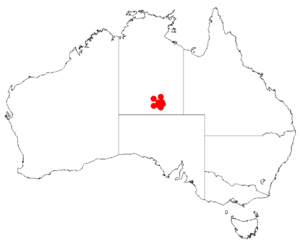Des Nelson wattle facts for kids
Quick facts for kids Des Nelson wattle |
|
|---|---|
| Conservation status | |
|
DD (TPWCA)
|
|
| Scientific classification | |
| Genus: |
Acacia
|
| Species: |
desmondii
|
 |
|
| Occurrence data from Australasian Virtual Herbarium | |
| Synonyms | |
|
Acacia nelsonii Maslin |
|
The Des Nelson wattle (scientific name: Acacia desmondii) is a type of shrub. It belongs to the Acacia family, which includes many kinds of wattles. This plant grows naturally in central Australia. Sadly, it is considered a vulnerable plant, meaning it's at risk of disappearing.
Contents
What Does It Look Like?
The Des Nelson wattle is a bushy plant that usually grows between 3 to 6 m (9.8 to 19.7 ft) (about 10 to 20 feet) tall. It can spread out to be 2 to 3 m (6 ft 7 in to 9 ft 10 in) (about 6 to 10 feet) wide, forming a thick, leafy top.
Bark and Branches
The bark on the lower part of its trunk is grey and looks like fibers. Higher up on the trunk and main branches, the bark changes to a reddish-grey color. This is called "minni ritchi" style bark, which means it peels off in thin, curly strips. The small branches are round (terete) and smooth (glabrous), meaning they don't have any hairs. They also have faint ridges.
Leaves (Phyllodes)
Like most Acacia plants, the Des Nelson wattle doesn't have true leaves. Instead, it has "phyllodes." These are flattened leaf stalks that act like leaves. The phyllodes are long and thin, staying green all year round. They get narrower towards the bottom and are sometimes slightly curved at the tip. They are also smooth (glabrous). Each phyllode is about 12 to 23 cm (4.7 to 9.1 in) (about 5 to 9 inches) long and very narrow, only 0.9 to 2.3 mm (0.035 to 0.091 in) wide. They are thick and have many fine lines running along them, with one main line that's hard to see.
Flowers and Seed Pods
This wattle blooms between July and November, showing off bright golden flowers. The flowers grow in cylinder-shaped spikes that are 1.5 to 3.5 cm (0.59 to 1.38 in) (about 0.6 to 1.4 inches) long. After the flowers, seed pods grow. These pods are fragile and smooth. They are long and thin, either straight or slightly curved. The pods are bumpy where the seeds are and squeezed in between them. They are 2.5 to 9 cm (0.98 to 3.54 in) (about 1 to 3.5 inches) long and 2 to 3.5 mm (0.079 to 0.138 in) wide, with wrinkles running lengthwise. Inside the pods, the seeds are shiny black and arranged in a line. They are oval-shaped, about 4 to 5 mm (0.16 to 0.20 in) long, and have a pale ring around a small opening (called an areole).
Why Is It Called That?
The scientific name Acacia desmondii honors a botanist named Des Nelson. He lived in Alice Springs and was the first person to collect this plant in 1964. The plant was first named Acacia nelsonii in 1980. However, that name had already been used in 1914 for a different plant from Mexico. So, the name was changed to Acacia desmondii to avoid confusion.
Where Does It Grow?
The Des Nelson wattle is "endemic" to a small area. This means it only grows naturally in this specific place. You can find it among the plains and hills of the Rodinga Range, Train Hills, and Pillar Range. These areas are located on Allambi Station and Todd River Station, which are south of Alice Springs in the southern part of the Northern Territory. It often grows along rocky streams and in dry, rocky valleys at the bottom of the ranges. It also likes to grow on rocky cliffs made of sandstone.

